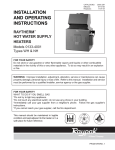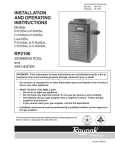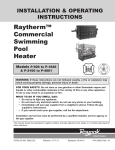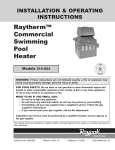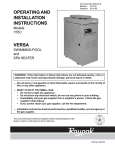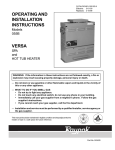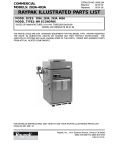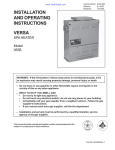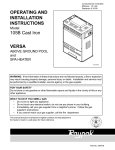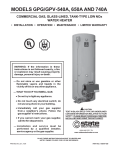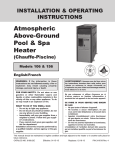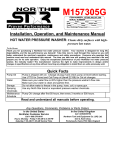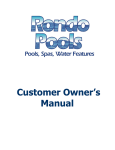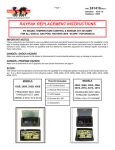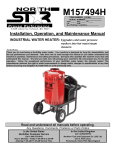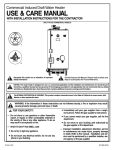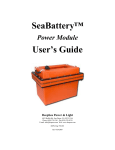Download Raypak C-R185B User's Manual
Transcript
CATALOG NO. 6000.52-AK Effective: 05-01-04 Replaces: 03-15-04 INSTALLATION AND OPERATING INSTRUCTIONS RP2100 SWIMMING POOL and SPA HEATER Atmospheric Models P-R185B to P-R405B C-R185B to C-R405B Low NOx Models P-R185BL to P-R405BL C-R185BL to C-R405BL Fig.# 9478 WARNING: If the information in these instructions is not followed exactly, a fire or explosion may result causing property damage, personal injury or death. — Do not store or use gasoline or other flammable vapors and liquids in the vicinity of this or any other appliance. — WHAT TO DO IF YOU SMELL GAS • Do not try to light any appliance. • Do not touch any electrical switch; do not use any phone in your building. • Immediately call your gas supplier from a neighbor's phone. Follow the gas supplier's instructions. • If you cannot reach your gas supplier, call the fire department. — Installation and service must be performed by a qualified installer, service agency or the gas supplier. This manual should be maintained in legible condition and kept adjacent to the heater or kept in a safe place for future reference. Part No. 240612 CONTENTS 4 PART ONE OWNER'S OPERATING INSTRUCTIONS 4 SECTION 1 START-UP PROCEDURES 4 5 Before Start-Up Lighting Instructions & Shut-Off ProceduresManually Lighted Pilots MV Operating Instruction & Shut-Off ProceduresAutomatically Lighted Pilots IID After Start-Up 6 7 7 SECTION 2 CAUTION 7 SECTION 3 MAINTENANCE & CARE PROCEDURES 8 8 9 Pool & Spa Water Chemistry Cold Weather Operation Winterizing the Pool & Spa Heater 10 PART TWO INSTALLATION & SERVICE INSTRUCTIONS 10 SECTION 1 RECEIVING EQUIPMENT 10 SECTION 2 GENERAL SPECIFICATIONS 11 SECTION 3 INSTALLATION INSTRUCTIONS 11 11 12 12 16 16 17 17 19 23 24 25 26 27 28 Code Requirements Clearances Outdoor Heater Installation Indoor Heater Installation Specifications and Dimensions Combustion Air Vent Piping Gas Supply Connections Plumbing For Water Connections Heat Exchanger Reversal Procedure Electrical Wiring Transformer Wiring Wiring Diagram-Millivolt (Mechanical Therm.) Wiring Diagram-IID (Atmospheric) Wiring Diagram-IID (Low NOx) 3 29 SECTION 4 SERVICING INSTRUCTIONS 29 29 30 31 32 34 34 34 34 35 35 35 35 35 36 36 36 36 36 37 General Location of Controls Millivolt Controls Digital Thermostat Controls Digital Diagnostics and Codes Remote Control and Operation Installation Pressure Switch Flame Roll-Out Safety Switch High Limit Pilot Safety Burner Drawer Removal Gas Valve Removal Main Burner and Orifice Removal Pilot Removal and Cleaning Heat Exchanger Removal Tube Cleaning Procedure Desooting Procedure Combustion Chamber Removal Immersion Well Replacement Unitherm Governor (U.G.) Replacement Low NOx Pool Heaters 39 SECTION 5 TROUBLE SHOOTING GUIDE 39 40 41 42 Mechanical Electrical MV Units Electrical IID Units Digital Control Logic 43 SECTION 6 REPLACEMENT PARTS 44 46 Illustrated Parts List Part Numbers PART ONE OWNER'S OPERATING INSTRUCTIONS FOR YOUR SAFETY - READ BEFORE OPERATING WARNING: IF YOU DO NOT FOLLOW THESE INSTRUCTIONS EXACTLY, A FIRE OR EXPLOSION MAY RESULT, CAUSING PROPERTY DAMAGE, PERSONAL INJURY OR LOSS OF LIFE. SECTION 1 - START-UP PROCEDURES Your Raypak Pool/Spa heater has been designed for years of safe and reliable pool/spa water heating. It is available in millivolt or electronic control options. ASME certified units, typical used in commercial applications, are also available. This manual provides operation, installation, maintenance, and service information for these heaters. ON OFF Fig.# 9472 If your heater has been installed correctly, operating the heater is an easy task. The upper front panel of the heater contains the control center that allows you to turn the heater on or off and adjust the temperature settings for the pool or spa. The temperature range is factory set from 65°F (18°C) to 104°F (40°C). The heater is also equipped with a toggle switch to turn the heater on and off, see fig. # 9472 above for location. Section 4 of this manual contains more details about the use of the controls in the Controls Adjustments subsection (page 29). BEFORE START-UP BURNERS Clean main burners, combustion fan and air louvers of dust, lint and debris. Keep heater area clear and free from combustibles, flammable liquids and chemicals. Do not obstruct the flow of combustion and ventilating air. WATER Water must be flowing through the heater during operation. Insure that system is filled with water and have pump operating. Fig.# 9478 RP2100 DIGITAL IID POLYMER 4 CAUTION: Propane gas is heavier than air and will settle on the ground. Since propane can accumulate in confined areas, extra care should be exercised when lighting propane heaters. LIGHTING INSTRUCTIONS AND SHUT-OFF PROCEDURES MANUALLY LIGHTED PILOTS MILLIVOLT SYSTEM A. This appliance has a pilot that must be lit by hand. When lighting the pilot, follow these instructions exactly. B. BEFORE LIGHTING smell all around the appliance area for gas. Be sure to smell next to the floor because some gas is heavier than air and will settle on the floor. *If you cannot reach your gas supplier, call the fire department. C. Use only your hand to push in or turn the gas control knob. Never use tools. If the knob will not push in or turn by hand, do not try to repair it. Call a qualified service technician. Force or attempted repair may result in a fire or explosion. WHAT TO DO IF YOU SMELL GAS: D. Do not use this appliance if any part has been *Do not try to light any appliance. under water. Immediately call a qualified serv*Do not touch any electric switch; do not use ice technician to inspect the appliance and to any phone in your building. replace any part of the control system and any *Immediately call your gas supplier from a gas control which has been under water. neighbor's phone. Follow the gas supplier's instructions. LIGHTING INSTRUCTIONS 1. STOP! Read the safety information above. 2. Set the thermostat on the lowest setting. 3. Turn On/Off switch to the "Off" position. 4. Remove heater door panel. 5. Push in gas control knob slightly and turn clockwise to "Off". NOTE: Knob cannot be turned from "Pilot" to Off" unless knob is pushed in slightly. Do not force. HONEYWELL PILOT ROBERTSHAW PILOT 6. Wait 5 minutes to clear out any gas. If you then Fig. # 8083.0 Fig. # 8084.1 smell gas, STOP! Follow "B" in the safety information above. If you don't smell gas, go 8. Turn knob on gas control counter-clockwise to the next step. to "Pilot" 7. Locate pilot mounted on the right side panel of 9. Place flame to end of pilot tube. Push in the burner drawer. For burner drawer location, control knob all the way and hold to light pilot. see location of control section, page 20. Continue to hold control knob in for about one GAS CONTROL KNOB SHOWN IN OFF POSITION minute after the pilot is lighted, release knob and it will pop back up. Pilot should remain HONEYWELL lighted. If it goes out, repeat steps 5 through 9. GAS VALVE *If knob does not pop up when released, stop MILLIVOLT and immediately call your service technician or gas supplier. 10. Stand to the side of the heater and turn the gas control knob counter clockwise to "On". 11. Replace heater door panel. 12. Turn On/Off switch to the "On" position. ROBERTSHAW 13. Set thermostat to the desired setting. Fig. # 8081.0 GAS VALVE MILLIVOLT Fig. # 8079.0 TO TURN OFF GAS TO APPLIANCE 1. Set the thermostat to the lowest setting. 2. Turn On/Off switch to the "Off" position. 3. Remove heater door panel. 4. Push the gas control knob slightly and turn clockwise to "Off". Do not force. 5. Replace heater door panel. 5 CAUTION: Propane gas is heavier than air and will settle on the ground. Since propane can accumulate in confined areas, extra care should be exercised when lighting propane heaters. OPERATING INSTRUCTIONS AND SHUT-OFF PROCEDURES AUTOMATICALLY LIGHTED PILOTS ELECTRONIC IGNITIONS SYSTEMS A. This appliance is equipped with an ignition device which automatically lights the pilot. Do not try to light the pilot by hand. *If you cannot reach your gas supplier, call the fire department. B. BEFORE OPERATING, smell all around the appliance area for gas. Be sure to smell next to the floor because some gas is heavier than air and will settle on the floor. C. Use only your hand to push in or turn the gas control knob. Never use tools. If the knob will not push in or turn by hand, don't try to repair it; call a qualified service technician. Force or attempted repair may result in fire or explosion. WHAT TO DO IF YOU SMELL GAS: *Do not try to light any appliance. D. Do not use this appliance if any part has been *Do not touch any electric switch; do not use underwater. Immediately call a qualified servany phone in your building ice technician to inspect the appliance and to *Immediately call your gas supplier from a replace any part of the control system and any neighbor's phone. Follow the gas supplier's gas control which has been underwater. instructions. OPERATING INSTRUCTIONS 1. STOP! Read the safety information above. GAS CONTROL KNOB SHOWN IN "ON" POSITION 2. Set the thermostat to the lowest setting. 3. Turn off all electric power to the appliance. HONEYWELL 4. This appliance is equipped with an ignition GAS VR 8300 GAS device which automatically lights the pilot. INLET VALVE IID Do not try to light the pilot by hand. 5. Remove heater door panel. 6. For Honeywell Valve: Turn gas control knob clockwise to "Off". For Robertshaw valve: Turn gas control knob clockwise to "Off".(Models ROBERTSHAW 7000 265-405) Push in and move gas control GAS VALVE IID MODEL 265-405 lever counter-clockwise to "Off" position. (Model 185) 7. Wait 5 minutes to clear out any gas. If you then smell gas STOP! Follow "B" in the safety information previously stated. If you Fig. # 8080.0 don't smell gas, go to the next step. GAS CONTROL 8. Turn gas control knob counter-clockwise LEVER SHOWN to "On". (Honeywell VR 8300 and IN "OFF" Robertshaw 7000) POSITION ROBERTSHAW 9. Replace heater door panel. 7200 GAS VALVE 10. Turn on all electric power to the appliance. IID MODEL 185 11. Set thermostat to desired setting. GAS 12. If the appliance will not operate, follow the INLET instructions "To Turn Off Gas To Appliance" and call your service technician or gas Fig. # 8934.1 supplier. TO TURN OFF GAS TO APPLIANCE 1. Set the thermostat at the lowest setting. to "Off". Make sure knob rest against stop. 2. Turn off all the electric power to the appliance For Robertshaw 7200 gas valve. if service is to be performed. Push in and move gas control lever counter3. Remove heater door panel. clockwise to "Off" position. 4. For Honeywell VR 8300 and Robertshaw 5. Replace heater door panel. 7000 gas valve. Turn gas control knob clockwise 6 AFTER START-UP SECTION 2 - CAUTION Feel the inlet and outlet pipes. Outlet pipe should be only slightly warmer than the inlet. It should not be hot. Elevated water temperature can be hazardous, and the U. S. Consumer Product Safety Commission recommends the following guidelines: WARNING: Should overheating occur or the gas supply fail to shut off, turn off the manual gas control to the appliance. 1. Spa or hot tub water temperatures should never exceed 104°F (40°C). A temperature of 100°F (38°C) is considered safe for a healthy adult. Special caution is suggested for young children. VISUAL INSPECTION With the heater on, remove the door and make a visual check of the pilot and burner. The flame should be blue with a well-defined pattern. 2. Drinking of alcoholic beverages before or during spa or hot tub use can cause drowsiness which could lead to unconsciousness and subsequently result in drowning. 4" MAX 3. Pregnant Women Beware! Soaking in water over 102°F (39°C) can cause fetal damage during the first three months of pregnancy resulting in the birth of a brain-damaged or deformed child. Pregnant women should stick to the 100°F (38°C) maximum rule. Fig. # 8205.2 MAIN BURNER FLAME 4. Before entering the spa or hot tub, users should check the water temperature with an accurate thermometer; spa or hot tub thermostats may err in regulating water temperatures by as much as 4°F (2.2°C). 5. Persons with a medical history of heart disease, circulatory problems, diabetes, or blood pressure problems should obtain a physician's advice before using pools or hot tubs. Fig. # 8964.1 6. Persons taking medications which induce drowsiness, such as tranquilizers, antihistamines, or anticoagulant, should not use spas or hot tubs. PILOT BURNER FLAME A yellow or "floating" flame indicates restricted air openings or incorrect orifice size. Should this occur, shut the heater off and contact your installer or gas supplier. SECTION 3 - MAINTENANCE AND CARE PROCEDURES WATER PRESSURE SWITCH A water pressure switch is provided in the heater to shut off the burners in the event that water supply to the heater is interrupted. It is very important to verify that the switch electrically opens and shuts off the gas valve when water flow to the heater is interrupted. Otherwise, rapid and severe damage will likely occur to the heater. (The water pressure switch should be checked and adjusted for proper operation by a qualified service person at the time of installation and periodically checked thereafter. Refer to Pressure Switch Adjustment on pg. 34 of this manual). To be followed one month after start-up and then semiannually. 1. Inspect top of heater and drafthood for soot, a sticky black substance around finned tubes and "V" baffles), and open flue gas passage ways. Any visible soot should be cleaned for proper operation. CAUTION: Soot may be combustible. Wet sooted surfaces completely prior to cleaning. Do not use steel wire brush. 2. Clean main burners and pilot burner of dust and lint. WARNING: Operation of the heater without water circulation will cause rapid and severe damage to the heater. 3. Inspect and operate all controls, gas valve and pressure relief valve. 7 4. Make visual check of the burner and pilot flame. Flame pattern on the main burner and pilot is indicated in the previous illustration. Yellow flame means restriction of the air openings. Lifting or blowing flame indicates high gas pressure. Low flame means low gas pressure. Should the latter occur, shut the heater off and contact your gas supplier or qualified service agency. AUTOMATIC CHLORINATORS AND CHEMICAL FEEDERS All chemicals must be introduced and completely diluted into the pool or spa water before being circulated through the heater. Do not place chlorine tablets or bromine sticks in the skimmer. High chemical concentrations will result when the pump is not running (e.g. overnight). 5. On indoor heaters, clean room intake openings to assure adequate flow of combustion and ventilation air. Chlorinators must feed downstream of the heater and have an anti-siphoning device to prevent chemical backup into the heater when the pump is shut off. CAUTION: Combustion air must not be contaminated by corrosive chemical fumes which can damage the heater and void the warranty. NOTE: High chemical concentrates from feeders and chlorinators that are out of adjustment will cause very rapid corrosion to the heat exchanger. Such damage is not covered under the warranty. 6. Keep area around heater clear and free from combustible materials, gasoline and other flammable and corrosive vapors and liquids. COLD WEATHER OPERATION IMPORTANT FREEZE INFORMATION BASIC TIPS IF HEATER WILL NOT FIRE: MODERATE CLIMATE: Heater operation can continue during short term cold spells. When temperatures are below freezing, flow (continuous pump operation) must be maintained. If you have no electrical power; it may be your "circuit breaker" has tripped. Try re-setting it. If you have electrical power but the heater will not fire check the following: CAUTION: Do not use the heater to maintain water temperatures just above freezing or for freeze protection. When heater is used during freezing weather, care must be taken to avoid freeze ups. Continuous pump operation is a must. Additional protection may be required. The heater is not warranted against freeze ups. 1. The time clock must be moved to the "ON" position. 2. Your pump strainer basket may be full. If so remove debris. 3. Your filter may be dirty. If so, backwash or clean filter. (To tell if your filter is dirty, look to see if the filter pressure will be higher than usual). COLD CLIMATE: Prolonged operation with water temperatures below 50°F is not recommended. When starting the heater with pool temperatures below 50°F operate the heater continuously until higher temperatures are reached. Operating the heater for prolonged periods with pool water below 50°F can seriously damage the heater, and is not covered by the warranty. 4. The pump may have lost it's prime. It may be running dry, check the pressure on the filter. If there is no pressure; then you are not moving water (or your gauge is broken). Try to get the pump to run at it's normal flow rate. For cold climate areas, please follow the winterizing procedures listed. POOL & SPA WATER CHEMISTRY Chemical imbalance can cause severe damage to your heater and associated equipment. Maintain your water pH between 7.4 and 7.8 and total alkalinity between 100 and 150 p.p.m. If the mineral content and dissolved solids in the water become too high, scale forms inside the heat exchanger tubes, reducing heater efficiency and also damaging the heater. If the pH drops below 7.2, the heater will be severely damaged. This will result in corrosion of the heat exchanger. Heat exchanger damage resulting from chemical imbalance is not covered by the warranty. 8 WINTERIZING THE POOL & SPA HEATER Heaters installed outdoors in freezing climate areas are subject to be shut down for the winter. Observe the following procedure for winterizing the heater: 1. Turn off gas valve, manual gas valve, and electrical supply to the heater. 2. Open drain plug located on the inlet/outlet header, (under water pipes). Remove the heat exchanger inspection panel on the side opposite water piping to gain access to the drain plug on the return header. Open drain plug on return header. Return Header Drain Plug 3. For ASME Heaters only: Disconnect compression fittings from the pressure switch and return header that connects to the 1/4" copper tube and allow the tube to drain. For ASME Heaters only. 9 PART TWO INSTALLATION AND SERVICE INSTRUCTIONS SECTION 1 - RECEIVING EQUIPMENT On receipt of your equipment it is suggested that you visually check for external damage to the carton. If the carton is damaged, a note should be made on the Bill of Lading when signing for equipment. Remove the heater from the carton and if it is damaged, report the damage to the carrier immediately. Save the carton. These items are shipped loose inside the carton with the heater: 1. 2. 3. 4. STANDARD UNIT (POLYMER HEADERS) "Pagoda" Top 2" CPVC Union with "O" rings (2) Plastic pipe finish flange for gas line Bonding lug with mounting screw (IID units only) 1. 2. 3. 4. 5. 6. 7. 8. 9. ASME UNIT (CAST IRON HEADERS) "Pagoda" Top In/Out Flanges (2) 1-1/2" Flange Gaskets (2) 2" Flange Gaskets (2) Flange Bolts (4) Pressure Relief Valve 2" CPVC Adapters (2) Plastic pipe finish flange for gas line. Bonding lug with mounting screw. (IID units only). Be sure that you receive the number of packages indicated on the Bill of Lading. When ordering parts, you must specify model and serial number of heater. When ordering under warranty conditions, you must also specify date of installation. (Raypak recommends that this manual be reviewed thoroughly before installing your Raypak pool/spa heater. If there are any questions that this manual does not answer, please contact the factory or your local Raypak representative.) SECTION 2 - GENERAL SPECIFICATIONS These heaters are design certified and tested under the requirements of ANSI Z21.56 / CSA 4.7 American National Standard / CSA Standard for Gas-Fired Pool Heaters. All heaters can be used either indoor or outdoors. The appropriate top designated for that type of use is required. If desired, the top can be changed at a later date to change from outdoor to indoor or vice versa. Millivolt heater contains a self-generating electrical system operating between .25 and .75 volts. Ambient Temperature Rating of Heater Components Millivolt Heater with Honeywell Gas Valve +32°F to +175°F Millivolt Heater with Robertshaw Gas Valve 0°F to +175°F Electronic Ignition Heaters* -32°F to + 175°F *Requires 120V or 240V Power Supply Atmospheric heaters: Rated inputs suitable for up to 2000 feet elevation. For elevations above 2000 feet, reduce input 4% for each 1000 feet above sea level, as high elevation reduces combustion performance. Low NOx heaters: Rated inputs suitable for up to 5000 feet elevation. For elevations above 5000 feet, consult the factory. 10 SECTION 3 - INSTALLATION INSTRUCTIONS CALIFORNIA PROPOSITION 65 WARNING: This product contains chemicals known to the State of California to cause cancer, birth defects or other reproductive harm. IMPORTANT NOTICE These instructions are intended for the use of qualified personnel only, specifically trained and experienced in the installation of this type of heating equipment and related system components. Installation and service personnel may be required by some states to be licensed. If your state is such, be sure your contractor bears the appropriate license. Persons not qualified shall not attempt to fix this equipment nor attempt repairs according to these instructions. WARNING: Improper installation, adjustment, alteration, service or maintenance may damage the equipment, create a hazard resulting in asphyxiation, explosion or fire, and will void the warranty. CODE REQUIREMENTS NOTE: The heater should not be located in an area where possible water leakage will result in damage to the area adjacent to the appliance or to the structure. When such locations cannot be avoided, it is recommended that a suitable drain pan, adequately drained, be installed under the appliance. The pan must not restrict combustion air flow. An alternative method for providing a base for combustible floors is illustrated below. Heaters must not be installed on carpeting. 12" Minimum E AT HE Fig. # 8148.1 4" Minimum Sheet Metal 24 Gauge Utilize hollow concrete cinder blocks, align holes and leave ends open. CLEARANCES ALL HEATERS For clearances from combustible surfaces, see the chart below. CLEARANCE FROM COMBUSTIBLE CONSTRUCTION INDOOR INSTALLATIONS: Back - 6" Top*- 30"(Drafthood) Front - Alcove Right Side - 12" (Water Side) Vent - 6" Left Side - 6" Installation must be in accordance with local codes, or, in the absence of local codes, with the latest edition of the National Fuel Gas Code, ANSI Z223.1 and National Electrical Code, ANSI/NFPA 70, and for Canada, the latest edition of CAN/CGA-B149.1 and B149.2, and Canadian Electrical Code, CSA C22.1 Part 1 and Part 2. BASE INSTALLATION Heater must be mounted on a level base, such as cement slab, cement blocks or other non-combustible surface. An optional non-combustible base is available for all models. R 12" Minimum (Opposite Water side) OUTDOOR INSTALLATION: Top* - Unobstructed (Stackless top or outdoor stack) Back - 6" Side - 6" *Clearance from top of vent terminal When installed according to the listed minimum clearances from combustible construction materials, the Raypak pool heaters can still be serviced without removing permanent structural construction around the heater. However for ease of servicing, we recommend a clearance of at least 24" in the front, and at least 18" on the water connection side. This will enable the heater to be serviced in its installed location, that is, without movement or removal of the heater. Clearances less than these (6" minimum), may require removal of the heater to service either the heat exchanger or the burner tray. In either case, the heater must be installed in a manner that will enable the heater to be serviced without removing any structure around the heater. 11 OUTDOOR HEATER INSTALLATION These heaters are design certified for outdoor installation, when equipped with the approved tops designated for outdoor use. WARNING: The heater shall not be located in an area where water sprinklers, or other devices, may cause water to spray through the cabinet louvers and into the heater. This could cause internal rusting or damage some electrical components, and this would void the warranty. WARNING: Do not install within 3 feet of a heat pump or an outdoor condensing unit. Strong air intake from these equipment can disturb the combustion process and cause damage or personal injury. HEATER WITH OUTDOOR STACKLESS TOP VENT TERMINAL (Outdoor) Stackless Top Installation 1. Insert tabs into keyhole (4 places). Pagoda Top (Shipped Loose with Heater) 2. Snap tabs into keyholes so as not to pull out. Fig. # 8278.2 Fig. #RP8280.1 Heaters must not be installed under an overhang of less than three (3) feet from the top of the heater. Three (3) sides must be open in the area under the overhang. Roof water drainage must be diverted away from the heaters installed under overhangs with the use of gutters. For U.S. installations,the point from where the flue products exit the heater must be a minimum of four (4) feet below, four (4) feet horizontally from, or one (1) foot above any door, window or gravity inlet into any building. The top surface of the heater shall be at least three (3) feet above any forced air inlet, or intake ducts located within ten (10) feet horizontally. U.S. Installations only For installations in Canada, pool heaters shall not be installed with the top of the vent assembly within 10 feet below, or to either side, of any opening into the building. Refer to the latest revisions of CAN/CGA-B149.1 and B149.2. Fig# 8245.1 12 INDOOR HEATER INSTALLATION The design is also certified for indoor installation when equipped with the approved draft hood. For Canada, indoor installation is restricted to an enclosure that is not occupied and does not directly communicate with occupied area. Refer to the latest edition of CAN/CGA-B149.1 and B149.2 for specific requirements. Locate heater as close as practical to a chimney or gas vent. Heater must always be vented to the outside. See Vent Piping section (pg. 17) for venting details. Minimum allowable space is shown on the nameplate. WARNING: Indoor boilers require a drafthood that must be connected to a vent pipe and properly vented to the outside. Failure to follow this procedure can cause fire or fatal carbon monoxide poisoning. OUTDOOR STACK / INDOOR STACK INSTALLATION NOTE: The outdoor and indoor stack are optional equipment and do not come standard with the heater. OUTDOOR KIT INCLUDES: 1- Draft hood, painted 1- Adapter plate 3- Mounting brackets (clips) 1- Top panel cover 2- 1 foot sections of metal tape 3- Screws 1- Instructions INDOOR KIT INCLUDES: 1- Draft hood, unpainted 1- Adapter plate 3- Mounting brackets (clips) 3- Screws 1- Instructions Clips Clips Model 185 265 335 405 OUTDOOR STACK Part No. 006751 006752 006753 006754 INDOOR STACK Part No. 006696 006697 006698 006699 ASSEMBLY PROCEDURE 1. Make sure that the gas and electricity to the unit has been turned off. 2. Remove the "pagoda" top from the louvered top and discard. See Fig. 3. 3. Remove the louvered top and set aside, saving the four phillips screws for reassembly. See Fig. 3. 4. Remove and discard the rain shield. See Fig. 4. 5 Install adapter plate on top of heater flue collector. See Fig. 5. 6. Reinstall louvered top on heater and fasten with Phillips screws set aside in step 3. 13 SECURING THE TOP PANEL COVER INDOOR KIT ONLY 7. Reinstall the louvered top. 8. Mount the draft hood onto the adapter plate lip inside the heater. See Fig. 6. 9. Proceed to installing the clips, step 14. SECURING THE TOP PANEL COVER OUTDOOR KIT ONLY 10. After removing the drafthood from the box, slide the top panel cover over the draft hood. 11. Holding both pieces together, mount the draft hood on the adapter plate lip inside the heater. See Fig. 6. 12. Take the two pieces of tape and attach to each side of the drafthood leaving 6" hanging down. 13. Slide the top panel cover up and attach the tape to the underneath side. This is to temporarily keep the top panel cover out of the way while you are attaching the clips as shown in the next steps. See Fig. 7. INSTALLING THE CLIPS INDOOR & OUTDOOR KITS 14. Notice that there are three pilot holes above the base of the drafthood as shown in Fig.8. These are the locations where the three clips are to be attached. 15. Insert the long edge of one clip between the top panel cover and the drafthood, see Fig. 9. 16. With a twisting motion, rotate the clip up, see Fig. 10. 17. Pull up on clip, see Fig. 11. 18. Hold the clip up and align the clip hole to the pilot hole, see Fig. 12. 19. Insert screw into hole and secure using a 5/16" nut driver. 20. Repeat steps 15-19 using remaining two clips. 21. This completes the indoor drafthood installation. If installing an outdoor drafthood, proceed to step 22. 14 INSTALLING THE TOP COVER OUTDOOR KIT ONLY 22. Remove the two pieces of metal tape holding the top panel cover up and discard. 23. Insert the rear two tabs into the slots on the heater top and slide the top panel cover backwards. See Fig.13. 24. Lower the top panel cover and using your thumbs, push tabs in and insert the two front tabs into the slots on the top of the heater. See Fig.14. 25. Lower the top panel cover flush to the top and release the tabs. They will spring into place as shown in Fig.15. 26. Turn the gas and electricity to the heater on. 15 SPECIFICATIONS AND DIMENSIONS Shipping Weights (lbs) Heater Model R185B R265B R335B R405B BTUH Input (000) 181 264 334 399 (A) Cabinet Width 18-1/4" 22-3/8" 25-3/4" 29-1/4" (B) Flue Dia. 6" 7" 8" 9" (C) Indoor Drafthood 62-5/8" 62-7/8" 63-3/4" 65-3/8" (J) 12-1/16" 11-1/8" 10-3/4" 12-1/2" Gas Conn. 3/4" 3/4" 3/4" 3/4" Water Conn. 2" 2" 2" 2" Cast Iron Heater w/Stackless Top Capron Heater w/Stackless Top Indoor Drafthood 191 214 234 253 172 195 215 234 12 15 17 20 *Designation for Propane is "EP", Natural gas is "EN". Prefix "C" is for Cast Iron (ASME) Headers; "P" is for Plastic (Polymer) Headers. Atmospheric heaters: reduce input 4% for each 1000 ft. above sea level when installed above 2000 ft. elevation. Low NOx heaters: for elevations above 5,000 feet consult factory. For Canada, no de-rating is required for elevations up to 4500 feet. Manufactured under Patent No. 3,623,458. Note: Plastic (Polymer) headers cannot be used for ASME installations. Fig # 9037.2 *Electrical Connection On Left Side is 19-1/8". COMBUSTION AND VENTILATION AIR (Indoor Units Only) a. All Air From Inside The Building: Each opening shall have a minimum net free square inches as noted: The heater must have both combustion and ventilation air. Minimum requirements for net free air supply openings, one opening that is 12 inches from the ceiling for ventilation and one opening that is 12 inches from the floor for combustion air as outlined in the latest edition of the National Fuel Gas Code, ANSI Z2231(Canada-CAN/ CGA-B149.1 and B149.2) and any local codes that may have jurisdiction. CAUTION: Combustion air must not be contaminated by corrosive chemical fumes which can damage the heater and void the warranty. 16 Model Square Inches Model Square Inches 185 181 335 333 265 264 405 399 b. All Air From Outdoors: When air is supplied directly from outside of building, each opening shall have a minimum net free square inches as noted: Model Square Inches 185 46 265 66 335 84 405 100 VENT PIPING WARNING: Indoor boilers require a drafthood that must be connected to a vent pipe and properly vented to the outside. Failure to follow this procedure can cause fire or fatal carbon monoxide poisoning. Vent piping the same size as the draft hood outlet is recommended, however, when the total vent height is at least ten (10) feet (draft hood relief opening to vent terminal), the vent pipe size may be reduced as specified in Chapter 10 of the National Fuel Gas Code, ANSI Z 223.1 (Canada-CAN/CGA-B149.1 and B149.2). As much as possible avoid long horizontal runs of vent pipe and too many elbows. If installation requires horizontal non-vertical runs, the vent pipe must have a minimum of 1/4 inch per foot rise and should be supported at not more than five foot intervals. Plumbers tape, criss-crossed, will serve to space both horizontal and vertical piping. Gas vents supported only by the flashing and extending above the roof more than five feet should be securely guyed or braced to withstand snow and wind loads. We recommend use of insulated vent pipe spacer through the roofs and walls. Another option for installation that requires horizontal runs is using the D-2 power vent kit option. Power Vent Kit Model Part No. 185 008086 265 008086 335 008087 405 008087 The discharge opening must be a minimum of two feet vertically from the roof surface and at least 2 feet higher than any part of the building within 10 feet. Vent stack shall be at least five feet in vertical height above the drafthood outlet. The vent cap location shall have a minimum clearance of 4 feet horizontally from, and in no case below, unless a 4-foot horizontal distance is maintained, from electric meters, gas meters regulators and relief equipment. The weight of the vent stack or chimney must not rest on heater draft hood. Support must be provided in compliance with applicable codes. The heater top and draft hood must be readily removable for maintenance and inspection. Vent pipe should be adequately supported to maintain proper clearances from combustible construction. Type "B" double wall or equivalent vent pipe is recommended. However single wall metal vent pipe may be used as specified in the latest edition of the National Flue Gas Code ANSI Z 223.1 (Canada-CAN/CGAB149.1 and B149.2). Fig. #RP 8119.2 Fig. # 9469 Optional Raypak D-2 Power Vent For more detailed D-2 installation information consult the D-2 Power Vent manual 6000.57. The power vent assembly is a fan-assisted combustion system designed for application to Raypak Pool Heater Models 185-405. The unit, when installed as directed, is capable of operating in applications such as through-thewall venting and reduced horizontal and vertical vent pipe sizes in new and current installations. It is certified for Category III venting up to 40 feet equivalent 4" diameter venting. The unit is factory wired for 240V, with capability of rewiring for 120V. GAS SUPPLY CONNECTIONS Gas piping must have a sediment trap ahead of the heater gas controls, and a manual shut-off valve located outside the heater jacket. All gas piping should be tested after installation in accordance with local codes. Fig. #RP 8090.0 CAUTION: The heater and its manual shut off valve must be disconnected from the gas supply during any pressure testing of that system at test pressures in excess of 1/2 psig (3.45 KPA). Dissipate test pressure in the gas supply line before reconnecting the heater and its manual shut off valve to gas supply line. FAILURE TO FOLLOW THIS PROCEDURE MAY DAMAGE THE GAS VALVE. OVER PRESSURED GAS VALVES ARE NOT COVERED BY WARRANTY. The heater and its gas connections shall be leak tested before placing the appliance in operation. Use soapy water for leak test. DO NOT use open flame. For protection against rain or blockage by snow, the vent pipe must terminate with a vent cap which complies with the local codes or, in the absence of such codes, to the latest edition of the National Fuel Gas Code, ANSI Z223.1 (Canada-CAN/CGA-B149.1 and B149.2). 17 NOTE: Do not use Teflon tape on gas line pipe thread. A flexible sealant is recommended. ELECTRONIC IGNITION GAS VALVES-CONTINUED A minimum of 7" W.C. and a maximum of 14" W.C. upstream pressure under load, and no load conditions must be provided for natural gas or a minimum of 12" W.C. and a maximum of 14" for propane gas. GAS PRESSURE REGULATOR The gas pressure regulator is preset at 4" W. C. for natural gas, and 11" W. C. for propane gas. The pressure at the gas valve, taken with a manometer, should be about 3.7" W. C. natural gas (3.9" W.C. for Low NOx) and 10.5" W. C. propane gas. If an adjustment is needed, remove seal and turn adjustment screw clockwise to increase pressure or counter-clockwise_____to decrease pressure. Fig # 9328 Fig # 9329 Gas Pressure Adjustment Robertshaw 7200 Model 185 Robertshaw 7000 BDER Model 265-335 Gas Pressure Adjustment Fig # 9327 Robertshaw 7000 DERHC Model 405 PIPE SIZING FOR GAS CONNECTIONS Fig. # 8149 Fig. # 9365 ATMOSPHERIC LOW NOx GAS PRESSURE ADJUSTMENT LOCATIONS MILLIVOLT GAS VALVES Low NOx units are not available in propane. Gas Pressure Adjustment Fig # 9263 Robertshaw 7000 Models 185 thru 405 ELECTRONIC IGNITION GAS VALVES Gas Pressure Adjustment Honeywell VR8304 Models 185 thru 405 Fig # 9264 18 PLUMBING FOR WATER CONNECTIONS HEATER LOCATION (Relative to the pump and filter) The RP 2100 heater requires water flow and positive pressure to fire and operate properly. It must therefore be installed downstream of the discharge side of the filter pump. A typical installation is plumbed as follows: 1. The inlet side of the filter is plumbed directly to the discharge side of the filter pump; 2. The outlet side of the filter is then plumbed to the inlet of the heater; and 3. The outlet of the heater is plumbed to the return line to the pool or spa. The pump, filter and heater are thus plumbed in series. Plumbing from the heater back to the pool must not have any valves or restriction that could prevent flow when the pump is operating. CAUTION: An additional source of heated water, e.g. a solar system, must be connected to the main line ahead of the heater inlet pipe in order for it to act as the primary heat source. If the primary system provides adequate heat to maintain set-point, the RP2100 heater will not fire. Be advised that the RP2100 control panel will then display sensed water temperatures downstream of the primary heating system, rather than the temperature of the water exiting the pool. POLYMER HEADERS POLYMER HEADERS (STANDARD MODELS) Before attaching the 2-inch unions to the inlet/outlet header, make sure the o-rings are properly seated in the grooves. Use AquaLube or equivalent non-petroleum based lubricant on the o-ring. Hand tighten the unions. Glue PVC piping directly to the unions. INLET/OUTLET HEADER (Polymer) Flange Gasket Heater must be located so that any water leaks will not damage the structure of adjacent area. PVC pipe may be glued directly into header unions. Header Flange (CPVC) FLOW RATES Header Flange Nut (CPVC) MODEL 185 265 335 405 PIPE SIZE MIN.GPM *MAX.GPM 1-1/4"-1-1/2" - 2 20 125 1-1/4"-1-1/2" - 2 25 125 1-1/4"-1-1/2" - 2 35 125 1-1/4"-1-1/2" - 2 40 125 Inlet *When flow rates exceed maximum GPM an external auxiliary bypass valve is required. See external bypass valve section for details. Fig. #2002.1 High temperature CPVC Header Flanges and header Flange Nuts are provided. If there is any possibility of back- siphoning when the pump stops, it is suggested that a check valve (or valves) also be installed in the system. ASME-Cast Iron 19 INLET/OUTLET HEADER - ASME CAST IRON HEADRERS (ASME MODELS) Heater must be located so that any water leaks will not damage the structure of adjacent area. High temperature 2" plastic pipe (CPVC) may be threaded directly into the header flanges. This is not the same as the Schedule 80 PVC pipe which is also colored gray. PVC may be used immediately after the CPVC adapters. Flange Gasket 2" CPVC Adapters Fig. # 8093.1 Header Flange UNITHERM GOVERNOR OPERATION ASME Inlet/Outlet Header PVC Pipe CAUTION: NEVER install PVC directly into header flanges. Use the 2" CPVC adapter supplied loose with the heater. DO NOT use petroleum base assembly fluids (such as Petroleum Jelly or lubricating oil). If assembly lube is required, use a silicon base such as Amoral etc. CAUTION: The patented Unitherm Governor is a thermostatic mixing valve specifically designed to maintain constant heater internal temperature between 105° to 115°F despite continually changing flow rates from the filter and changing pool temperatures. This narrow range is needed to prevent damaging condensation on the burners which will occur if the heater runs for any length of time below 100°F. It is also needed to inhibit scale formation in the tubes by maintaining temperatures well below accelerated scaling temperatures. There are two sets of flange gaskets supplied with your heater. Use the appropriate gaskets for all your heater connections. Discard unused set. GASKET DESIGN #1: Accepts 1-1/2" copper tube or 1-1/4" galvanized pipe as a slip connection. GASKET DESIGN #2: Accepts 2" copper tube as a slip connection. The flange is threaded for 2" screw in pipe connections. Also used with the 2" CPVC adapters. #1 #2 U.G. PLUG (Polymer) Fig. # 8095.1 UNITHERM GOVERNOR Fig. # 8097.1 GASKET 20 INTERNAL AUTOMATIC BY-PASS VALVE PRESSURE RELIEF VALVE INSTALLATION In addition to the Unitherm Governor, a built-in automatic by-pass valve is provided in the in/out header. While the Unitherm Governor responds to the changes in water temperature in the heater, the internal by-pass valve automatically responds to changes in water pressure in the piping system. Proper amount of water flow is maintained through the heater under varying pressures dictated by the conditions of the pump and filter. To conform to local building codes, it may be necessary to install a pressure relief valve. A 3/4" pressure relief valve having a capacity equal to BTU/HR output of the model to be installed is recommended for this heater. The maximum acceptable pressure relief valve setting is 125 psi. BYPASS DISC A 3/4" NPT connection is provided in the plastic header for installation of a pressure relief valve. The valve shall be installed in a vertical position. Do not over tighten. Install pressure relief valve hand tight plus 1/2 turn. POLYMER HEADER Pressure Relief Valve SPRING PRV Discharge Connection BYPASS BODY EXTERNAL AUXILIARY BYPASS VALVE (Where Required) An auxiliary bypass valve should be used when flow rates exceed 125 GPM (usually a high performance pump size larger than two horsepower will exceed this flow rate). This valve is required to complement the function of the automatic bypass valve, particularly when starting the heater in winter or early spring when the spa or pool temperature is down below 50°F. It also serves to eliminate needless pressure drop through the heater and accompanying reduction in the flow rate to the spa jets, etc. From Heater To Heater To Pool Inlet/Outlet Header Fig. #2004 A 3/4" NPT connection is provided in the header for installation of a pressure relief valve. The valve shall be installed in a vertical position. ASME HEADER (Cast Iron) Fig.#2003 Pressure Relief Valve PRV Discharge Connection From Pool AUXILIARY BYPASS VALVE (DO NOT USE GATE VALVE) Inlet/Outlet Header Fig. # 8150.0ss AUXILIARY BYPASS VALVE ADJUSTMENT To set bypass: With clean filter, adjustment is made by feeling the inlet and outlet pipes at the heater. Outlet pipes should be slightly warmer than inlet and comfortable to the touch. If pipe is hot, close bypass; if cold, open bypass. Fig. # 8095.0 NOTE: To avoid water damage or scalding due to valve operation, drain pipe must be connected to valve outlet and run to a safe place of discharge. Drain pipe must be the same size as the valve discharge connection throughout its entire length and must pitch downward from the valve. No shutoff valve shall be installed between the relief valve and the drain line. Valve lever should be tripped at least once a year to ensure that waterways are clear. 21 HEAT EXCHANGER PRESSURE DROP TABLES 22 HEAT EXCHANGER REVERSAL PROCEDURE (POLYMER HEADER MODELS) 1. Remove right and left side access panels (Figure 1). 2. Disconnect wires at high limit, AGS (automatic gas shutoff), and pressure switch on the inlet/outlet header (Figure 2). 3. Electronic Ignition Heaters: Remove the thermostat temperature sensor by loosening the compression fitting nut (Figure 3). Reroute the sensor to the left side of the heater. 4. Millivolt Heaters: Remove the temperature sensor bulb and retainer clip from the sensor well (Figure 4). Reroute the sensor bulb to the left side of the heater. 5. Remove (12) bolts holding the inlet/outlet and return headers to the tube sheets. Clean off tube sheet area where the gasket seats. Also clean off the header and the gasket. Apply a non-petroleum based lubricant to the gasket such as Aqua Lube. Reattach the headers to the opposite sides, making sure they are installed in an upright position (Figure 5). Do not over tighten. Torque should not exceed 7 ft/lbs. 6. Reconnect high limit, AGS, and pressure switch wires. 7. Electronic Ignition Heaters: Insert the temperature sensor in the compression fitting and tighten 1/2 turn past hand tight. 8. Millivolt Heaters: Insert sensor bulb and retainer clip into sensor well. 9. Allow for water flow through the heater and check for leaks. 10. Reattach access panels to the opposite sides. Fig. #1 ACCESS PANEL PRESS SWITCH AGS HI-LIMIT Fig. #2 JACO FITTING For ASME Models call your factory representative. Fig. #3 NOTE:Tighten almost flush (1/32" to 1/8") to the header to avoid leaks. BULB & CLIP REINSTALLED IN/OUT HEADER ON OPPOSITE SIDE. Fig. #4 Fig. #5 23 ELECTRICAL WIRING NOTE: If it is necessary to replace any of the original wiring, it must be replaced with 105° C wire or its equivalent, and/or 150° C wire or its equivalent as originally built. Control Box (Factory Mounted Location) Option Location For Left Side Field Wiring MILLIVOLT SYSTEM The Millivolt System residential heater is equipped with a self-generating electrical system in which the electric current is provided by means of a pilot generator. No external electrical connections are required. When installing a remote switch, do not exceed 10 feet of wiring from the heater. Use 18 gage stranded wire. Sway Brace ELECTRONIC INTERMITTENT IGNITION DEVICE SYSTEM (IID) Bonding Lug (Optional Location) NOTE: Heaters are factory wired for 240V power supply. The standard field wiring connection is on the right side of the heater. Fig. # 9470 Bonding Lug (Standard Location) ATMOSPHERIC Wiring locations To wire the heater from the left side, follow the steps below: 1. Remove the two (2) screws that hold down the junction box to the sway brace. Untie excess yellow wires located behind the junction box. 2. Move the junction box to the left side of unit and attach the box to the sway brace. 3. Secure 24V yellow wires to sway brace panel with existing wire retainers. 4. Connect the wires inside the junction box, either 120V or 240V depending on the field wiring. NOTE: 7/8" Dia. holes not utilized on jacket and control box can be used for fireman switch or auxiliary control interface wiring. Fig.# 9366.1 LOW NOx Wiring locations NOTE: Heater must be electrically grounded and bonded. Bonding lug is provided loose with the unit. Install bonding lug on lower right or left side of jacket as necessary for bonding the unit. Mounting hole is provided on the jacket. The Electronic Intermittent Ignition Device automatically lights the pilot and main burners upon a call for the heat. The heater is supplied with a dual voltage transformer for 120V or 240V input power hookup. 24 TRANSFORMER WIRING 120V WIRING For 120 V input power to the unit, connect the black wire to the “L1” or hot leg of the power supply. Connect the white wire to the “L2” or neutral leg of the power supply. Attach the wire nut to the red wire. There should be no connection to the red wire for 120V operation. For Low NOx pool heaters wire nut each red wire independently. Fig. #9471 240V WIRING For 240 V input power to the unit, connect the black wire to the “L1” or hot leg of the power supply. Connect the red wire to the “L2” or second hot leg of the power supply. Attach the wire nut to the white wire. There should be no connection to the white wire for 240V operation. For Low NOx pool heaters wire nut each white wire independently. Fig. # 9471.1 Heater must be electrically grounded and bonded in accordance with local codes, or, in the absence of local codes, with the latest edition of the National Electrical code, ANSI/NFPA 70. (Canada- Canadian Electrical Code, CSA C22.1, Part 1 and Part 2.) NOTE: Input power to the heater (120/240V) can be supplied from the load (pump) side of time clock or directly from the switch/GFCI power source. It is preferred to make connection to the load/pump side of the time clock. When using the switched GFCI power source the heater could display false service indicators on the delay panel if the pump is turned off. 25 WIRING DIAGRAM - MILLIVOLT (MECHANICAL THERMOSTAT) 26 WIRING DIAGRAM - IID (Atmospheric) 27 WIRING DIAGRAM - IID (Low NOx) 28 SECTION 4 - SERVICING INSTRUCTIONS CONTROL ADJUSTMENTS GENERAL LOCATION OF CONTROLS Bypass Temperature Adjust Buttons Hi Limit on I/O header (ASME on Return Header) Drain Plug (Located in Return Header) Mode Button ON AGS HiLimit (Located on Inlet/ Outlet Header) Digital Thermostat Circuit Board OFF Unitherm Governor Roll-Out Switch LCD Display Drain Plug Gas Valve Pilot Fig.# 9472 MILLIVOLT CONTROLS The pool or spa water temperature is controlled by the pool heater thermostat on the upper front panel of the heater. The control center contains an On/Off switch and one or two thermostats. Transformer Fig #2005 CONTROL PANEL REMOVAL 1. Remove (4) screws from sides of control panel. 2. Rotate control panel down until panel stops. Do not force. NOTE: Caution must be taken not to damage controls or wiring. Thermostats are fitted with a means of limiting the upper temperature limit below the maximum level. The knob stop adjustment ring illustrated below is adjustable by loosening the set screw, rotating the knobstop ring to the desired location and retightening the set screw. SPA TEMPERATURE RANGE POOL TEMPERATURE RANGE Control Panel Mounting Screws (4) STAND-BY TEMPERATURE KNOB STOP RING SET SCREW Fig. #9473 KNOB STOP SHOWN ABOVE IS IN THE SPA TEMPERATURE RANGE Fig. #RP 8267 29 DIGITAL THERMOSTAT CONTROLS Notice to owner- Thermostat operation Your heater is equipped with a microprocessor controlled thermostat that controls the pool or spa temperature by measuring the temperature of the water coming back through the heater. It will then monitor the water temperature and turn the heater back on when it senses that the water temperature is falling below the set point. It is normal to experience small fluctuations in the return water temperature during the operation of the heater. The thermostat is calibrated with a very close tolerance to ensure accuracy of the set temperature. Thus, slight fluctuations in water temperature may cause your heater to cycle on and off frequently. This phenomenon is not a problem. It will not harm the heater nor interfere with its function to precisely control the temperature of the pool or spa. Fig #9480 LCD DISPLAY TEMP BUTTONS MODE BUTTON PROGRAM MODE BUTTON THERMOSTAT CONTROL OPERATION The pool heater thermostat on the upper front panel of the heater controls the pool/spa water temperature. This control center contains a mode button, up and down temperature adjustment buttons, and a LCD display. Set Points The electronic thermostat cannot be set above selected maximum set points. The maximum default set points are factory set at 104°F for both pool and spa. These can be changed to a higher or lower value to suit your needs, but can never be set above 107°F. Mode Button The MODE button functions as a means to turn the heater off or on in either the pool or spa temperature setting. The LCD display indicates the mode the heater is in and the actual water temperature. Program Mode Button To adjust the set point, press the Mode button until the display reads OFF. Remove the four screws holding the control cover on. Swing control panel down so the back side of the board is visible (see page 27). Locate the Program Mode button as show in figure 9481. Temp Buttons If the mode is in POOL or SPA, the desired pool or spa temperature will also be displayed and may be changed using the UP or DOWN buttons. A manual toggle switch is also provided right below the MODE button to allow the heater to be turned off. Hold this button and use the Mode button to select “Set” on the digital display. You can release the button once “Set” appears. Using the “Up” and “Down” buttons will change the Maximum Temperature Setting. The control can be set for a maximum of 107°F. A separate value can be set for either Pool or Spa by using the Mode button to select Pool or Spa and using the “Up” and “Down” arrows to select the desired Max temp for each. Once this is done reassemble the control panel. Operation In the POOL or SPA modes, the actual water temperature is displayed along with the desired pool or spa temperature. If the heater is firing, a flame icon will be visible. Fahrenheit vs Centigrade The digital display is capable of displaying Centigrade as well as Fahrenheit temperatures. To change the display follow the instruction above to access the Program Mode Button. Hold this button and use the Mode button to select “F/C” on the digital display. The “Up” and “Down” buttons will select “F” or “C” on the temperature display. Once this is done reassemble the control panel. To adjust the desired pool or spa temperature setting, make sure the control is in the appropriate mode (POOL or SPA) and push the UP or DOWN buttons to get the desired set point temperature. MODE POOL or SPA DISPLAY call for heat WATER TEMPERATURE FLAME ICON Fig# 9484 Fig #9481 SET POINT TEMPERATURE 30 NOTE: The digital temperature display may not coincide with the temperature reading of your pool or spa thermometer. The RP2100 reads the water temperature at the inlet of the heater. Due to the circulation characteristics of any pool or spa, the water temperature at the inlet to the heater may differ from that observed at a given location in the pool or spa. DIAGNOSTICS The RP2100 Digital heater is equipped with on-board diagnostic controls. If there is a safety fault, a fault code will be displayed along with a service indication. If the PRS fault code is displayed, it indicates that there is insufficient flow through the heater. Make sure the pool filter and pump strainer are clean before calling a service representative. READING A FAULT The word “SERVICE” will flash on and off if the PC board detects a known fault. The fault will be displayed in three big letters on the lower left of the display. SERVICE WILL FLASH Fig# 9485 3 LETTER FAULT CODE See table for fault definition Fig# 9482 STATUS CODES Display Definition CFH Call for heat CLK Time clock LOW Caution - low water temperature OFF Off mode REM Remote control activated SPK Spark SPR Spare fault code indicator FAULT CODES Display Definition BD1 Board failure FFL Flame sensing when pilot and gas valves are closed HL1 Hi limit switch #1 open HL2 Hi limit switch #2 open IGN Ignition control failure ILO Ignition lock out PLT Pilot failure PRS Pressure switch open ROL Heat roll-out safety switch open SNS Sensor failure VNT Vent switch open PROGRAM MODES Display Definition CCC Celsius setting F/C Change from Fahrenheit to Celsius FFF Fahrenheit setting RES Reset defaults SET Set point max adjustment 31 REMOTE CONTROL INSTALLATION AND OPERATION Heating in the SPA Mode POOL COMMON (BLK/ORG) Remote Mode ACTIVATING THE REMOTE The RP2100 digital has the ability to disconnect from the remote it is wired to. To activate or deactivate the remote follow these steps: SPA COMMON (ORG/BLK) 24VAC HOT (BLU) Fig# 9494 Fig# 9488 Fig# 9486 Heating in the POOL Mode Press and hold all three buttons for 5 to 7 seconds. 7-PIN REMOTE WIRING CONNECTOR PART NUMBER 071494 REMOTE OPERATION The RP2100 Digital heater is equipped with the ability to work with external remote controls. The Raypak supplied 7-pin remote wiring connector supplies power out to either a toggle switch or the switch contacts of a third party remote. The remote works by either making or breaking the circuit created by the remote wiring. Typically, a remote does not supply power to the heater, it only provides a switching function to turn the heater on or off. If your remote is suppling its own voltage to the heater, it will not work with the RP2100 and may damage the digital circuit board. Fig# 9480 Fig# 9489 The digital display format will change and indicate REMoff or REMon. External remote control disabled Fig# 9490 OFF Mode Fig# 9484 Fig# 9487 CAUTION: Before installing remote controls to the RP2100 Digital Heater, read the following: The Raypak RP 2100 Digital Heater is remote ready in most cases. The digital liquid crystal display (LCD) shows the actual pool temperature, operating status, and service codes (See examples below). The touch pad on the control panel allows you to select the desired pool or spa temperature. It also indicates when a remote system is controlling the heater by displaying REM in the display. When connecting the RP2100 Digital to a remote system, identify whether it is a two- or three-wire remote system. Select the appropriate instruction listed below to properly install the remote to the heater. External remote control active Press either temperature button to switch remote modes. IMPORTANT - Please Read When the heater is to be controlled by a remote you must choose REMon and the heater thermostat display must be in the OFF mode. If the heater thermostat is left in a heat mode the heater will operate to this setting and the remote shut-off feature will not be functional. Note: Electrostatic Discharge (ESD) damage can be caused by direct or indirect contact with the wiring or circuit board. When one walks to the heater area, an electrostatic charge accumulates on the body. Contact of a finger allows the body to discharge, possibly causing device damage. This damage can be limited if the service person discharges himself by removing that charge by adhering to ESD preventative/removal practices and reducing that charge by holding on to the heater enclosure for 5 seconds before proceeding. 32 REMOTE CONTROL WIRING Important Installation Notes for Remote or External Wiring Configuration • Remote wiring must be run in separate conduit. • Remote wiring must not be run parallel to high voltage lines. • For runs of under 30 feet, remote wiring should have stranded conductors with a minimum of 22 AWG, 600V, cable twisting 1.5 to 2.5 and jacketed. • For runs over 30 feet, the conductors should be a minimum of 20 AWG, 600V, cable twisting 1.5 to 2.5 inch lay that is shielded and jacketed. • Maximum cable length is 200 feet. • For both two- and three- wire remote systems, the provided 7-pin wiring connector must be utilized. Please refer to the wiring instructions. Note: The remote wires must be connected to the 7-pin connector before it is connected to the board. 2-Wire Remote Control (On-Off) This application assumes that only one heating function is required. 1. Turn on power to the heater. 2. Push the mode button to the "POOL" or "SPA" mode and set the desired temperature for each. (eg. 102°F) 3. Turn the mode button to "OFF" and remove power from the heater. 4. On the "Remote Interface Harness" connect the BLUE wire to one side of the "REMOTE" switch and connect the other side to either the ORANGE/BLACK wire for "SPA" operation or the BLACK/ORANGE wire for "POOL" operation. 5. Place wire nut on unused wire on the "Remote Interface Harness." 6. Install the "7-Pin Remote Interface Harness" to the P8 connector and turn on power to the heater. Fig# 9492 See instructions on previous page to activate the remote control. 3-Wire Remote Control Using Three-Position Switch (Pool-Off-Spa, or Low-Off-High) This application assumes that multiple heating functions are required. 1. Turn on power to the heater. 2. Push the mode button to the "POOL" or "SPA" modes and set the desired temperature for each. (eg. 80° for Pool and 102°F for Spa) 3. Turn the mode button to "OFF" and remove power from the heater. 4. On the "Remote Interface Harness" connect the BLUE wire to one side of the "REMOTE" switch and connect the ORANGE/BLACK wire for "SPA" operation and the BLACK/ORANGE wire for the "POOL" operation. 5. Install the "Remote Interface Harness" to the P8 connector and turn power "ON" to the heater. Fig# 9493 See instructions on previous page to activate the remote control. 33 PRESSURE SWITCH The pressure switch, or heater actuator, insures that the heater operates only when the filter pump is in operation. It is located on the inlet/outlet header. It is factory set at 1.75 PSI for deck level installations. When the heater is located below the level of the spa or pool, it may be necessary to reset the pressure switch to compensate for the no-flow static head. If it is necessary to reset the pressure switch, utilize the following procedure: FLAME ROLL-OUT SAFETY SWITCH Atmospheric heaters are equipped with a thermal cutoff device to prevent flame roll-out in the event the heat exchanger becomes blocked. This is a "single-use" type fusible link or thermal fuse, that must be replaced when disabled by an over temperature condition, caused by excessive restriction in the heat exchanger flue passage. PRESSURE SWITCH ADJUSTMENT Fig. #9438 Adjustment Knob 1. With pump and heater on, turn adjustment knob clockwise until a click is heard from the gas valve. 2. Turn adjustment knob counter clockwise 1/4 turn. 3. Turn pump off and on several times. Heater should shut off immediately. If it does not, repeat steps above until proper adjustments made. Fig. #9440 HIGH LIMITS The heater is equipped with two automatic high limits. Both are located in the inlet/outlet header. Both are set to open at 135°F. NOTE: An erratic high limit is often characteristic of internal heat exchanger problem, e.g. scale buildup, defective bypass. Refer to troubleshooting sections (pg. 39). HIGH LIMIT REMOVAL 1. Shut off main electrical power switch to heater. 2. Remove inlet/outlet inspection panel. 3. Remove defective high limit and replace with a new high limit. 4. Replace inspection panel. PRESSURE SWITCH ADJUSTMENT RANGE Fig. # 9439 Fig. # 8152.2 NOTE: If heater is installed outside of the limits shown, a higher pressure rated (11 psi) switch may be used or a flow switch mounted and wired adjacent to the heater may be used in place of the factory mounted pressure switch. See Parts List (pg. 47) for 11 psi pressure switch. TWO-SPEED PUMPS In some cases, the flow on the low-speed is insufficient to operate the heater. This is apparent when the pressure switch cannot be further adjusted or if the heater makes banging noises or goes off on high limit. In these cases, the pump must be run at high speed when heating the water. CAUTION: Do not operate the heater without the function of a properly adjusted pressure switch or flow switch. PILOT SAFETY- Millivolt The heaters equipped with the standing pilot (millivolt system), have pilot generators which act as a safety device to shut off the flow of gas to the main burners and the pilot burner in case the pilot flame is extinguished. The pilot burner must be manually relighted to place the heater in operation again. Refer to the lighting instructions provided on the heater label. PILOT SAFETY- Electronic The heater employs a pilot safety which closes the main gas valve within 8/10ths of a second whenever the pilot flame is interrupted. Pilot flame is automatically lit when the device is powered. Unit performs its own safety check and opens the main valve only after the pilot is proven to be lit. 34 BURNER DRAWER REMOVAL 1. Shut off main electrical power switch to heater. 2. Shut off gas upstream of heater. 3. Remove front door. 4. Disconnect gas line from gas valve. 5. Remove (2) screws that mount burner tray to unit, and (2) screws that secure gas valve to jacket. 6. Disconnect wires that terminate at gas valve. 7. Slide out burner tray. 8. Reverse above procedure to reinstall. GAS VALVE REMOVAL 1. Shut off gas supply to the heater. Remove gas piping to gas valve inlet. 2. Disconnect wires, pilot tubing and bleed line, if required. 3. Turn vertical gas pipe from manifold slightly and unscrew gas valve. 4. Reverse above procedure to reinstall. PILOT REMOVAL AND CLEANING 1. Disconnect pilot tubing and wires from gas valve. 2. Remove pilot assembly from burner tray. 3. Remove pilot from bracket. 4. Remove pilot orifice and air opening (Honeywell MV unit only), and clean with wire or small brush. CAUTION! Do not enlarge hole in pilot orifice. 5. Reverse above procedure to reinstall. HONEYWELL PILOT Pilot ROBERTSHAW PILOT Pilot Air Opening MAIN BURNER AND ORIFICE REMOVAL 1. Remove burner drawer, following procedure above. 2. Remove screws and burner hold-down bracket. Orifice Orifice NOTE: If the heat exchanger is sooted badly, the burner hold-down bracket and spacer can become distorted from direct flame impingement and this usually necessitates replacement of these parts. 3. Lift burners from slotted spacers and slide from orifices. Clean with a wire brush. 4. Orifices usually do not need to be replaced. To clean, run either copper wire or wood toothpick through orifice. Do not enlarge hole. To remove orifice, use a socket wrench and remove from manifold. DO NOT overtighten when reinstalling. Burners Burner Hold-Down Bracket Fig. # 9479 35 Fig. # 8045.1 Fig. # 8102.0 HEAT EXCHANGER REMOVAL 1. Shut water, gas and electricity off, close valves and relieve pressure and remove relief valve. Remove side inspection panels. 2. Remove top holding screws. 3. Remove draft diverter, lift and remove top and flue collector. Remove inspection panels. 4. Disconnect wires from high limits and pressure switch. Remove temperature sensor. 5. Disconnect flange nuts on inlet-outlet header, loosen union(s) at gas pipe and slide boiler away from piping. 6. Lift heat exchanger straight up using caution not to damage refractory. 7. Reverse above procedure to reinstall. Make sure the insulation strips are properly replaced on top of the refractory retainer. Extension Pieces (2) Auger with Carbide Tip TUBE CLEANING PROCEDURE Establish a regular inspection schedule, frequency depending on local water condition and severity of service. Do not let the tubes clog up solidly. Clean out deposits over 1/16" in thickness. Wire Brush Fig. # 8154.0 IMMERSION WELL REPLACEMENT (Millivolt and ASME) 1. Shut water off to heater and drain heat exchanger. 2. Remove access panel on water connection side of heater. 3. Remove old immersion well with bushing and sleeve. 4. Install in header. The heater may be cleaned from the return header side, without breaking pipe connections. It is preferable, however, to remove both headers for better visibility through the tubes and to be sure the ground-up lime dust does not get into the system. NOTE: Installation in plastic should be hand tight plus 1/2 turn. Note that you do not remove the top panel or the heater exchanger, generally. After reaming, mount the wire brush in place of the auger and clean out debris remaining in the tubes. Well Assembly Another method is to remove the heat exchanger, ream tubes and immerse heat exchanger in non-inhibited descale solvent for severe scale buildup. DESOOTING PROCEDURE Fig. #2010 CAUTION: SOOT IS COMBUSTIBLE. EXERCISE EXTREME CARE: UNITHERM GOVERNOR (U.G.) REPLACEMENT 1. Shut water, gas and electricity off, close valves and relieve pressure. 2. Drain heat exchanger. 3. Remove retainer plug located next to the outlet pipe connection. 4. Unsnap old U.G. to remove from retainer plug. Snap in new U.G. 5. Reinstall retainer plug, taking care to lubricate gasket with a non-petroleum based grease such as AquaLube. Soot will clog areas between fins and cause eventual tube failure. Any sign of soot at the base of the burners or around the outer jacket indicates a need for cleaning. 1. Remove top and flue collector from cabinet. 2. Remove "V" baffles from heat exchanger. 3. Remove burner drawer. (See pg. 35). 4. Remove heat exchanger from the heater and wash with a garden hose, making sure soot is removed from spaces between fins. 5. Reverse above procedure to reinstall. NOTE: In extreme cases it may be necessary to do steam cleaning at the local car wash. DO NOT WIRE BRUSH. Retainer Plug U.G. Spring COMBUSTION CHAMBER REMOVAL To remove combustion chamber, you must first have removed the heat exchanger. Unbolt metal combustion chamber retainer from top and remove combustion chamber panels individually. Gasket Fig. #2011 To test the operation of the Unitherm Governor, place in hot water (over 100°F) and watch for movement against spring. If there is no movement, replace unit. Fig. #RP 8155.0 REFRACTORY PANELS-TOP VIEW 36 LOW NOx POOL HEATERS The Raypak Low NOx Pool Heaters are certified and tested under the ANSI Z21.56.CSA 4.7 standards for gas-fired pool heaters. BURNER ADJUSTMENT This burner assembly does not require any primary air adjustments. The heater should be installed to meet all local codes, the latest editions of the National Fuel Gas Code Z223.1 and the National Electrical Code, ANSI/NFPA 70. BLOWER ADJUSTMENT The Raypak RP2100 Low NOx pool heater is equipped with a combustion air baffle mounted at the air intake to the combustion air blower. The baffle has a slot that is utilized to align with a square window cutout on the shutter assembly. The factory setting will be adequate for most field conditions and adjustment will not normally be required. However in some cases, field conditions including unusual gas characteristics may create a need for adjustment to achieve optimum performance. When the combustion air setting is proper, there will be some lifting of the flames on some areas of the burner deck under coldstart conditions. After about five minutes of operation, the flames should settle down and blue tips should become visible. Lifting of flames beyond the five minutes would indicate too much combustion air. Loosening the knurled screw and opening the air baffle (move to the left) increases the amount of combustion air; closing it (move to the right) decreases the amount of combustion air. After a steady blue flame is attained, the knurled screw must be re-tightened. Fig # 9361 VISUAL INSPECTION Flame can be observed through the slot opening above the plenum. Flame color is blue and evenly spread on the top surface of the burner. At least every three months a visual inspection should be made of the burners. In case flame lifting is observed on the burner, check gas pressure in manifold. Gas pressure in manifold should be 3.9" W.C. OPERATION On call for heat, the ignition system, consisting of an electronic spark module, gas valve and pilot system, is energized. Providing the pilot is proven blower will start running, the main gas valve will open and the heater will operate. When the operating control is satisfied the heater will shut down. ELECTRICAL Be sure that electrical service to the boiler has proper overload fuse or circuit breaker protection, wire size and connections which comply with all applicable codes. START-UP PROCEDURES 1. Turn on power to the heater with gas supply off. 2. Check ignition as follows: a. Set the thermostat or controller to call for heat. b. Watch for continuous spark at the pilot burner. c. Check the ignition spark operation. Time must be within the lockout timing period (15 or 90 seconds). d. Turn control down to end call for heat and wait 60 seconds on lockout models before beginning step 3. 3. Turn on gas supply. 4. Set controller to call for heat. 5. System should start as follows: a. Spark will turn on, pilot gas valve will open, and the blower will begin running. b. Heater will operate until call for heat is satisfied. FLAME ROLL-OUT SAFETY SWITCH Low NOx heaters are equipped with a cutoff device to prevent flame roll-out in the event the heat exchanger becomes blocked. This is a "manual reset" type roll-out switch that must be reset by a service technician after any over temperature conditions have been fixed. Excessive restriction in the heat exchanger flue passage may cause the switch to disable the heater. 37 LOW NOx HEATERS (CONTINUED) 7. Reverse above procedure to reinstall. IID PILOT Fig # 9477 Fig # 9362 PILOT REMOVAL LOW NOx BURNER TRAY ASSEMBLY 1. Disconnect pilot tubing from gas valve. 2. Remove (4) screws from control box. Open the control box. 3. Remove the pilot wire from the ignition wire. 4. Remove (2) screws that mount the pilot bracket to the air manifold assembly. 5. Pull the pilot bracket slightly, then drop and pull downwards and outwards. 6. Reverse above procedure to reinstall. Make sure the pilot bracket is all the way up on the pilot side, see drawing below. BURNER DRAWER REMOVAL 1. 2. 3. 4. 5. 6. 7. 8. 9. 10. 11. Shut off main electrical power switch to heater. Shut off gas upstream of heater. Remove front door. Disconnect gas line from gas valve. Remove (2) screws that mount burner tray to the base of the unit, and (2) screws that secure gas valve to jacket. Disconnect wires that terminate at gas valve. Unscrew (4) screws that secure the control box. Disconnect pilot wire from the ignition module. Disconnect wire harness from the combustion blower. Carefully slide out the burner tray assembly. Reverse above procedure to reinstall. GAS VALVE REMOVAL 1. Remove burner drawer, following above procedure. 2. Disconnect, pilot tubing from gas valve. 3. Turn vertical gas pipe from manifold slightly and unscrew gas valve. 4. Reverse above procedure to reinstall. MAIN BURNER AND ORIFICE REMOVAL 1. Remove burner drawer, following above procedure. 2. Remove pilot. See pilot removal procedure. 3. Remove (8) total screws from the hold down brackets, front and rear of tray. 4. Remove (8) total screws from the left and right sides of the manifold assembly. Detach the manifold assembly from the burner tray assembly. 5. Remove burners by raising the bracket on the back end of the burners up and out of their slots. 6. Use a long 9/16” socket wrench to remove orifices from the gas manifold. Fig# 9368 COMBUSTION FAN REMOVAL 1. Remove burner drawer. See Burner Drawer Removal procedure on this page. 2. Remove (4) screws that mount the combustion blower to the manifold assembly. 3. Reverse above procedure to reinstall. 38 SECTION 5 - TROUBLESHOOTING GUIDE MECHANICAL (FOR QUALIFIED SERVICE PERSONNEL ONLY) IMPORTANT NOTICE These instructions are primarily intended for the use of qualified personnel specifically trained and experienced in the installation of this type of heating equipment and related system components. Installation and service personnel may be required by some states to be licensed. Persons not qualified shall not attempt to install this equipment nor attempt repairs according to these instructions. PROBLEM CAUSE SOLUTION Harmonics, or whining noise U.G. inoperative.................................... Check movement by putting in hot water (110°F or higher). If no movement, replace. Locate the restriction and remove. Flush system and clean. Remove debris or blow out gas line. Scale forming in heat exchanger - clean heat exchanger and check pool pH and total alkalinity. *Debris or restriction in system............ *Debris in gas line................................. Low flow.............................................. Heater going on and off continuously Dirty filter.............................................. Low water level in pool........................ External bypass setting out of adjustment............................................ *Pressure switch out of adjustment............................................. Backwash filter. Raise water level. Liming or scale forming on heat exchanger Pool water............................................. Recommended pH should be between 7.4 and 7.8 Total alkalinity 100-150 PPM maximum. Hardness 150-400 PPM maximum. Sooting High flow rates..................................... Reduce by adding manual bypass valve. Adjust manual bypass valve until heater outlet water temperature is between 105° and 110°F. Check movement by putting in hot water (110°F or higher). If no movement, replace. Refer to installation instructions. Follow recommended installation instructions. U.G. Inoperative.................................... *Air starvation....................................... *Improper venting.................................. *Insects or debris clogging burner intake ports............................... Adjust bypass Adjust pressure switch Clean burners. Pilot outage Low gas pressure................................ Restricted pilot...................................... Weak pilot generator............................. Yellow lazy flame Low gas pressure................................ Adjust gas pressure. *Insects or debris clogging burner intake ports............................... Clean burners. Outer jacket very hot (paint blistered) *Broken refractory caused by shipping damage or improper combustion.......................................... Excessive sooting of heat exchanger........................................... Determine cause of sooting & correct. Calculate temperature in °/hr................ Heat rise (°/hr.)= Takes long time to heat pool or spa. Filter not running long enough............... Dirty filter............................................... Gas line or meter undersized................ Adjust gas pressure. Clean pilot. Replace pilot. Replace refractory panels. Htr. output Pool gallonage x 8.33 or refer to heater sizing chart. This does not take into account heat loss due to weather. Reset time clock. Clean filter. Refer to installation instructions. Liming Bypassing too much water................... Inspect bypass for movement, if no movement, replace. U.G. not functioning.............................. Replace if no movement when heated. Leaking at well. Overacid............................................... Replace well and maintain water chemistry properly. Leaking at heat exchanger. Overacid............................................... Replace heat exchanger and maintain chemistry properly. Gasket brittle and leaking (overheated). Heater running after pump shuts off............................................... Refractory damage............................... Sooted heater....................................... See pressure switch adjustment. Replace refractory. Determine cause of sooting and correct. Combustion fan not running Fan relay............................................... Fan........................................................ Burned motor ....................................... Replace fan relay Loose connection or failed motor Incorrect wiring, replace blower * Indicates symptom which usually occurs on initial start-up. 39 ELECTRICAL (STANDING PILOT MILLIVOLT) RAYPAK POOL OR SPA HEATER ELECTRICAL CHECK WITH MV GAS VALVE CAUTION: For qualified service personnel only. 1. Filter must be on with adequate water flow through heater. 2. Gas valve must be "ON" position. Thermostat set higher than pool water temperature. 3. Jumpers are for temporary check only. If left in place, they could cause the heater to burn up. Light pilot If pilot burner goes out when main burner lights or when gas valve knob is released If pilot burner remains lit. Jump across both "TH" wires on gas valves If main burner fires, remove jumper If main burner does not fire, remove jumper Replace gas valve Jump across pressure switch terminals If pilot burner stays on If main burner fires, remove jumper If main burner does not fire, remove jumper Clean filter Jump across thermostat Check for adequate water flow from filter If main burner fires, remove jumper Replace pressure switch Replace thermostat Remove both "TH" wires from gas valve. Relight pilot If pilot burner does not light Check gas supply, gas line size, gas pressure. Also check for insects or debris in pilot output. If burner does not remain lit, attach millivolt meter and read pilot output. Problem is a wire or component short to cabinet or low gas pressure If main burner does NOT fire... Jump across each high limit and remove jumper Replace high limit that caused heater to fire If above 500mV, replace gas valve If below 500mV, check gas pressure. Also check for insects or debris in the pilot burner If output is still low, replace pilot generator. 1 Raw Output (700mV± 100) Pilot generator disconnected from valve (knob must be held down to keep pilot on). White – Negative Red + Positive 2 Pilot Load (500mV± 100) Pilot generator connected to valve-Power applied to pilot solenoid. TP(Thermopile-Robertshaw) PP(Power Pile-Honeywell) TH TP – Common TH PP – Common 3 Main Valve Load (200mV± 100) Control/Limit circuit closed (All switches "ON") TP(Thermopile-Robertshaw) PP(Power Pile-Honeywell) TH TP – Common TH PP – Common 40 ELECTRICAL (ELECTRONIC IGNITION IID) TROUBLESHOOTING WARNING HIGH VOLTAGE For qualified technicians ONLY NOTE: Some heaters may be equipped with an ignition module that shuts off pilot gas if pilot fails to light. To reset, interrupt power to heater. START TURN GAS SUPPLY OFF. TURN THERMOSTAT (CONTROLLER) TO CALL FOR HEAT POWER TO PC BOARD? (24 V NOMINAL) YES NOTE: Before troubleshooting, familiarize yourself with the start-up and checkout procedure. NO Check line voltage power, low voltage transformer, limit controller, thermostat (controller) and wiring. Pull ignition lead and check spark at PC board. SPARK ACROSS IGNITER/SENSOR GAP? YES NO Spark Okay? YES • Check ignition cable, ground wiring, ceramic insulator and gap, and correct. • Check boot of the ignition cable for signs of melting or buckling. Take protective action to shield cable and boot from excessive temperatures. TURN GAS SUPPLY ON PILOT BURNER LIGHTS? YES NO • Check that all manual gas valves are open, supply tubing and pressures are good, and pilot burner orifice is not blocked. • Check electrical connections between PC board and pilot operator on gas control. • Check for 24 Vac across PV-MV/PV terminals on PC board. If voltage is okay, replace gas control; if not, replace PC board. NOTE: If PC board goes into lockout, reset system. Lockout is used on L.P.G. models. MAIN BURNER LIGHTS? YES NO • Check for 24 Vac across MV-MV/PV terminals. If no voltage, replace module. • Check electrical connections between PC board and gas control. If okay, replace gas valve or gas control operator, i.e. pilot gas valve, flow switch etc. SYSTEM RUNS UNTIL CALL FOR HEAT ENDS? YES NO NOTE: IF PC board goes into lockout, reset system. • Check continuity of ignition cable and ground wire. NOTE: If ground is poor or erratic, shutdowns may occur occasionally even though operation is normal at the time of checkout. • Check that pilot flame covers flame rod and is steady and blue. • If checks are okay, replace PC board. CALL FOR HEAT ENDS SYSTEM SHUTS OFF? YES TROUBLESHOOTING ENDS NO • Check for proper thermostat (controller) operation. • Remove MV lead at module; if valve closes, recheck temperature controller and wiring; if not, replace gas valve. Repeat procedure until trouble free operation is obtained. 41 DIGITAL CONTROL LOGIC - FLOW CHART 42 SECTION 6 - REPLACEMENT PARTS NOTE: To supply you with the correct part it is important that you supply the model number, serial number and type of gas when applicable. If determined defective by the Company and within warranty, a like part or equal substitution will be returned, freight collect. Credit will not be issued. Any part returned for replacement under standard company warranties must be properly tagged with a Raypak return parts tag, completely filled in with the heater serial number, model number, etc., and shipped to the Company freight prepaid. RAYPAK, INC. 2151 Eastman Avenue Oxnard, CA 93030 For Canada: RAYPAK CANADA LTD. 2805 SLOUGH STREET MISSISSAUGA, ONTARIO L4T 1G2 43 ILLUSTRATED PARTS LIST 44 LOW NOx BURNER TRAY PILOT ASSEMBLIES 2-P 2-P 4-P 4-P 7-P 7-P 9-P 9-P 10-P 10-P Honeywell IID Atmospheric units Fig. #8124 for units produced prior to 06/01/2000 Honeywell IID Low NOx and Atmospheric units for units produced after to 06/01/2000 Use KIT Number 008155F for Low NOx units Use KIT Number 002003F for Atmospheric units 1-P 5-P 8-P 6-P 3-P 9-P Honeywell MV Fig. #8107 45 Fig. #9369 46 47 48 51 www.raypak.com Raypak, Inc., 2151 Eastman Avenue, Oxnard, CA 93030 (805) 278-5300 Fax (800) 872-9725 Raypak Canada LTD, 2805 Slough Street, Mississauga, Ontario, Canada L4T 1G2 (905) 677-7999 Fax (905) 677-8036 Litho in U.S.A.




















































